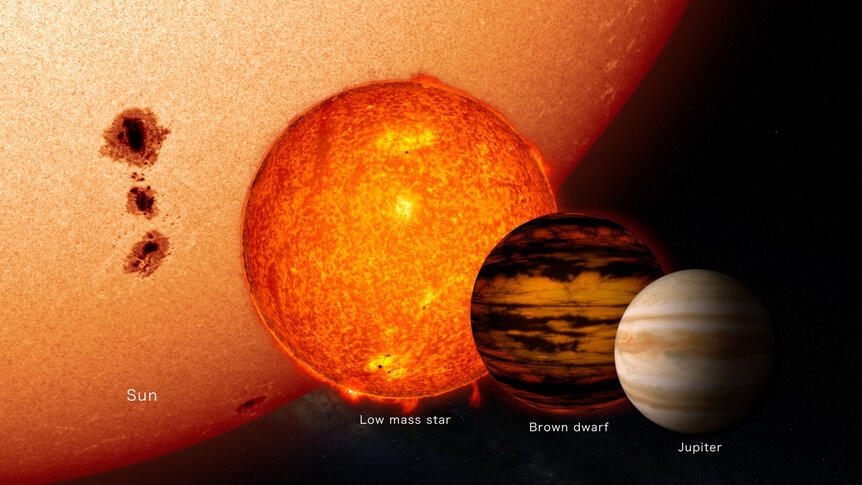Create a free profile to get unlimited access to exclusive videos, sweepstakes, and more!
When is a planet not a planet? When it’s actually a star
Astronomers find a handful of planets are actually stars.

In the time since the first planets orbiting another star — called exoplanets — were discovered in the early 1990s, astronomers have found a lot more, and the number has now passed the 5,000 mark.
But a team of astronomers is taking that number backwards, just a little. They’ve found three previously detected planets, and maybe a fourth, that aren’t planets at all. They’re stars.
Very low mass small stars, but still stars, masquerading as planets in the observations [link to paper].
Most planets are found using the transit method, where we see their orbits edge-on and once per orbit they pass in front of their host star, making a mini-eclipse. We can’t see the planet directly, but we do see the light from the star dim a bit. How much it dims depends on the size of the star and the size of the planet; a big planet blocks more light than small one. If we know how big the star is and how much it dims, we can calculate the size of the planet. In part a star’s characteristics come from knowing its distance, though there are other methods for estimating its size.
NASA’s Kepler space observatory stared at one patch of sky for years, measuring the brightnesses of about 150,000 stars, and detected thousands of planets via their transits. Since that time NASA launched TESS, the Transiting Exoplanet Survey Satellite, also looking for planets. It observed many of the same stars Kepler did, but in the time between the missions, better numbers for many star distances have been measured.
The astronomers saw that while the estimates for diameters of the vast majority of stars were very similar for both missions, some stood out as pretty discrepant. In general, ones that were off were for stars that were very far away, more than about 4,000 light years. Stars that far away have distances that get tough to measure, so this is no surprise. And in fact, the distances used by Kepler were too small; the stars in reality are farther away.
If the stars are farther away, they’re bigger than previously thought. And if you then look at the planets found around those stars, they have to be bigger too, because their size is measured relative to their host star.
They then looked at the ratio of the sizes of the planets and their stars in both the TESS and Kepler data and compared them. Four planets immediately jumped out as being much larger than previously measured. These were the planets Kepler-699b, 747b, 840b, and 854b.
They looked at Kepler-854b first. They found that over time, the host star itself changed brightness slightly, getting brighter and dimmer in a regular period. However, that period was the same as the planet’s orbital period! That’s very suspicious; why would a star brighten and dim at the same rate as the planet orbits?
What they found is that the star’s brightness change is consistent with it not being round, but instead being somewhat egg or teardrop shaped. Now, this is what you expect if the second object in that system is very massive; the gravity of the second object pulls the first into an elongated shape. When they calculate the mass of the second object needed to account for the star’s shape, they find it has to be over 100 times the mass of Jupiter.
Oof. An object more than about 80 times Jupiter’s mass can generate enough pressure in its core to ignite nuclear fusion. That makes it a star, though a low-mass one. So right away it looks like Kepler-854-b is a star, not a planet. They also find the host star is over twice as large as previously thought, making the “planet” three times the diameter of Jupiter. That’s way too big; planets just cannot get that size without becoming stars. Again, it must be a star.
They found similar results with Kepler-699b and 840b as well. The stars are farther away than first thought and therefore bigger, and that makes the planets bigger too. They also found some subtle arguments showing that the Kepler-840b must be a star as well; in secondary eclipse, when it goes behind its host star, the system drops in light a lot more than you’d expect if it were a planet. But if it’s a star it generates its own light, and when it gets blocked you’d see the total light from the system dimming by more than you would for a planet.
Kepler-747b follows the same path; they find the star is four times bigger than thought before, so the planet is a little under twice Jupiter’s size. That’s not quite enough to completely rule it out as a planet, but it’s close enough that they think its planetary status is questionable.
So what does this mean for exoplanets in general? Are we about to find a ton more of them aren’t planets at all?
That’s unlikely. Remember, the huge majority of the sizes of the host stars Kepler looked at didn’t change, so they’re OK. And going forward the distances to stars are much better known, thanks to observations by ESA’s Gaia mission, which has done an incredible job measuring how far away over a billion stars are. Yes, a billion.
So if you’re keeping your eye on the scoreboard, yes, the refs had to call back a handful of points here. But 3 or 4 out of 5,000 is a pretty low correction, and only sets us back a few days, really, given how rapidly planets are detected. We’ll hit that 1.6-kilometerstone pretty soon.
Rest assured, the sky is filled with planets, probably as numerous as stars in the galaxy. It’s a lot of planets, and we can afford to find out a few aren’t real. In fact we must, because the whole point of science is to correct mistakes and learn from them. In this case, happily, the lesson isn’t too painful.





























